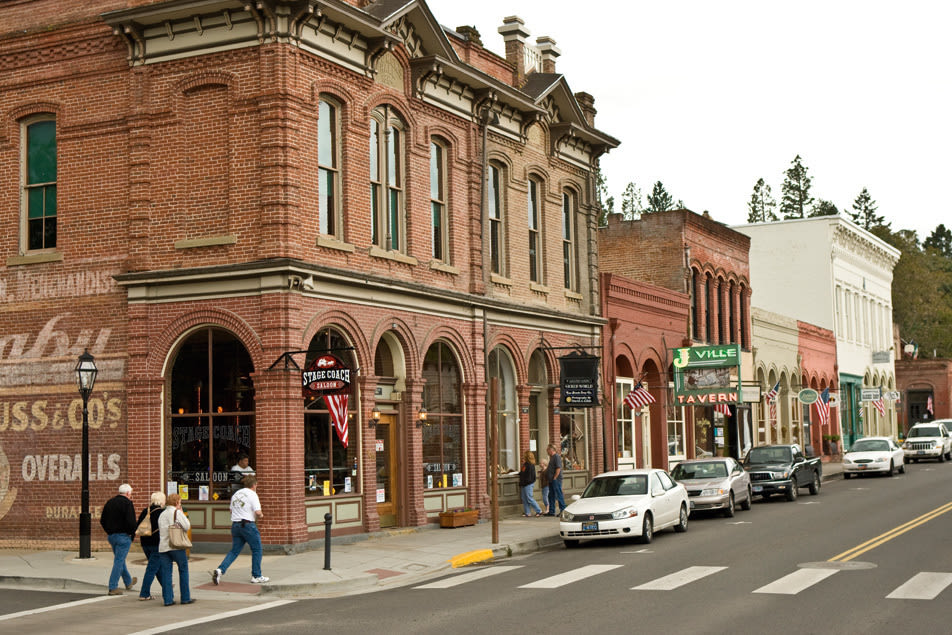Gold Standard

Image: Jared Cruce
AS A GENERAL RULE, I’m suspicious of towns that market themselves as “charming.” Not only is that term often synonymous with another word—“tacky”—but it implies that the town actively clings to the past while eschewing sophistication. Simply put, “charming” isn’t something I typically look for in a vacation spot.
But Jacksonville, a 1.8-square-mile hamlet nestled in Southern Oregon’s Rogue Valley, 5 miles west of Medford and 15 miles north of Ashland, is one of those rare early-American towns that has embraced modernity without losing an iota of its historic, well, charm.
“Our history is how we survive around here. It’s Jacksonville’s product,” says Larry Smith, the town’s unofficial history guru, while chatting with me outside the GoodBean Coffee Company, a bustling espresso shop on the corner of N Oregon and California Streets. The scrappy, 60-something Smith is getting ready to lead a walking tour through Rich Gulch, a lush, 103-acre nature preserve on the northwest side of town that boasts a stunning view of Jacksonville and its bucolic surrounds from the crest of Panorama Point (just off the three-mile Rich Gulch Trail).
But more important, this swath of nature is where packers James Cluggage and James Pool “found color” in their pans in December 1851 while watering their mules at Daisy Creek near Table Rock City (as Jacksonville was then known). Gold is how Jacksonville came to be and how it thrived as Oregon’s financial center for over 30 years—until the Southern Pacific Railroad was routed through neighboring Medford in 1884 and commercial interests migrated east.
En route to his tour’s meeting spot, Smith shows me a few of the town’s 100 or so original buildings that still stand: The churchlike Jacksonville City Hall, built in 1880, is the oldest functioning city hall building in Oregon; the two-cell jail from 1882 (which today is maintained just for show) and the firehouse (now a museum that houses an original hook-and-ladder fire wagon) both sit across the street from the GoodBean espresso shop, coexisting easily with the 21st-century lifestyles led by Jacksonville’s 2,200 or so residents.
Smith then leads me through Britt Gardens, the two-acre park where famed Swiss-German photographer and horticulturist Peter Britt, who planted the region’s first vineyards in 1855, once lived. For 46 years it’s also been the site of Jacksonville’s banner event, the Britt Music Festival, which runs from June to September and features an array of blues, country, pop, rock, and classical artists.
As we climb the grassy hill that faces the empty amphitheater, Smith says that the festival lures around 80,000 people to the town every summer, along with thousands of tourist dollars. Which is partly why locals are so adamant that Jacksonville’s other main product—historic charm—is preserved.
Indeed, there was a time when the town’s quaint soul was threatened. In 1964 the Oregon Highway Commission sought to redirect Highway 234 through downtown. Residents threw a fit—and then they got creative: By petitioning to designate Jacksonville as a National Historic Landmark, they realized they might be able to keep the bulldozers at bay and thus preserve their original architecture. After a successful campaign, the town was named a National Historic Landmark City in 1966.
“We went from sleepy ghost town to bona fide tourist attraction,” says Scott Clay, of the town’s chamber of commerce. “It probably saved us from extinction.”
The designation means that Jacksonville is subject to reviews by the National Park Service, which requires the city to (agreeably) enact strict design-code ordinances. Meeting these standards was challenging for Mike Thornton, who recently built Britt Cottage, a bed-and-breakfast on Third Street. But the hard work paid off: Although the cottage is new and outfitted with flat-screen TVs and Wi-Fi, the Craftsman-style structure fits seamlessly into the town’s aesthetic. “[These codes] are good for business,” says Thornton, 48.
Strolling along California Street today, this seems especially true. There are almost a dozen restaurants nearby, where 20 years ago only the Jacksonville Inn and the burger joint Bella Union were thriving. There are also high-end boutiques, and across the street, a wine-tasting room, South Stage Cellars, housed in an 1865 brick cottage.
“Theater people from Ashland are staying in Jacksonville now,” says South Stage’s owner, Spirit Lount, 37. “You can’t corner the tourism market with a ‘corporate’ perspective. It’s all about charm.”
Jacksonville can now add wine to its list of alluring qualities. And having tasted a delectable viognier made by local winery Valley View, my interest is piqued. On my last day in town, I venture eight miles north on Highway 238 to explore the Applegate Valley Wine Trail, and within a minute, I am driving through an agrarian landscape of orchards, vineyards, and alpaca farms.
Just after the tiny town of Ruch, I turn left onto Applegate Road and see Valley View, the oldest of the area’s 13 wineries. The winery is owned by brothers Mike and Mark Wisnovsky, whose father, Frank, seeking his own brand of gold rush, moved his family here from New Jersey in 1972 to plant grapes. “With a thriving wine country a few miles away,” says Mark, 44, who lives in Jacksonville with his wife and two kids, “we’re the town that has everything.”
An hour later, I am back on California Street sitting in Jacksonville’s first (and only) sushi joint, Jazushi. I ask its owner, Sunni Suzuki, why she chose Jacksonville, of all places, to open a sushi restaurant. “I’d been here once before to visit family,” Suzuki says. “And I loved it so much. It is just so charming.” I had to agree.




